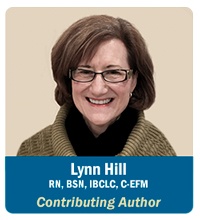[4 MIN READ]
Your Postpartum Patient
Your postpartum patient was not complaining. Her vital signs were stable. She had experienced a prolonged labor, but to your knowledge, her vaginal delivery the previous day went well. Her recovery seemed to be progressing nicely. The morning report did not reveal that she was at any risk.
It was her first baby, and she had declined to breastfeed. Her lochia flow had tapered nicely, and things are looking good. Then you are called to her room. The patient tells you that something is terribly wrong and that her abdomen is painful; you evaluate to find a rigid abdomen. You assess for bleeding and find none; you check again and find no bleeding.
She is panicked and shouting for help. She is not the same calm woman from 90 minutes earlier during your AM rounds when she denied any pain or discomfort. Now she is in panic mode and urgently seeking your assistance.
She Crashes Rapidly
Her vital signs remain stable, and there is still no visible bleeding. You assess her postpartum fundus; it is difficult to find because the abdomen is so rigid. She moans as you try to deeply palpate and assess for firmness. You think it’s firm; it certainly does not palpate boggy and she is not bleeding, so you believe it must be firm. But why is her abdomen so firm when there isn’t any bleeding? You think the fundus is firm, but why is she moaning when you touch her abdomen? Within minutes, your patient deteriorates right before your eyes. Her panicked breathing has changed from fast to shallow, and she passes out. There is an immediate and dramatic shift in vital signs. She is not responding to you calling her name. You don’t know what’s going on. Her heart rate plummets and she is very pale. A universal page goes out to the OB stat team.
Paging OB STAT Team
The primary physician and OB stat team are summoned for rapid response to this emergency. Your mind is racing as you try to figure out a differential diagnosis for this patient. The charge nurse casually mentions that the patient had a larger than normal blood loss in the initial postpartum period after a difficult placenta removal. A blood transfusion was never required, but her blood loss did seem to be more than expected; it was never measured quantitatively, but it was estimated to be 700 mls. You now recall that the hemoglobin and hematocrit were lower than usual when you checked her labs earlier.
The physician arrives and diagnoses secondary occult postpartum hemorrhage (PPH). What is your next move? Are you prepared for this unexpected crisis?
Exploratory Surgery
 The physician determines that medical management will not suffice and that surgery is necessary. The patient is rushed to the operating room. A secondary IV line is initiated and crystalloid fluids are wide open and flowing rapidly. The surgeon plans to do exploratory surgery to look for the cause of the occult bleeding and achieve hemostasis. As the belly is opened, pooled blood pours from the abdomen. The uterus is atonic and there is uncontrolled bleeding. You now realize it is possible your patient may die. Within minutes, her life has gone from happy and healthy to teetering on the edge of life and death. The surgeon informs everyone in the room that an emergency hysterectomy will be necessary. Additional surgical trays are opened as the surgeon works to control bleeding. Additional staff arrive to assist.
The physician determines that medical management will not suffice and that surgery is necessary. The patient is rushed to the operating room. A secondary IV line is initiated and crystalloid fluids are wide open and flowing rapidly. The surgeon plans to do exploratory surgery to look for the cause of the occult bleeding and achieve hemostasis. As the belly is opened, pooled blood pours from the abdomen. The uterus is atonic and there is uncontrolled bleeding. You now realize it is possible your patient may die. Within minutes, her life has gone from happy and healthy to teetering on the edge of life and death. The surgeon informs everyone in the room that an emergency hysterectomy will be necessary. Additional surgical trays are opened as the surgeon works to control bleeding. Additional staff arrive to assist.
Secondary Postpartum Hemorrhage
This is a case in which a patient came very close to dying due to an occult bleed and secondary PPH. While primary PPH occurs within the first 24 hours post-delivery, secondary PPH occurs after 24 hours and up to 12 weeks postpartum (mean is 13.4 days post-delivery). Secondary PPH is typically not as severe as primary PPH, but it is just as alarming; in rare cases, bleeding can place the patient in a hemodynamically unstable situation. Two-thirds of patients with secondary hemorrhage will have experienced primary PPH; one-third have Von Willebrand disease (an inherited clotting disorder). Uncontrolled postpartum bleeding is often the first sign of undiagnosed Von Willebrand. Only 10% of cases will experience change of vital signs in the early onset; clinical presentation may be nonspecific and have overlapping etiologies.
Vital signs may remain stable for a long time while occult bleeding and infection coexist. Also, healthy women can lose up to one liter of blood before any change of vital signs is witnessed, leading to an abrupt turnaround of vital signs with rapid patient deterioration as hemorrhage evolves. By the time the combination of hypotension and tachycardia occurs, there has already been substantial blood loss that could represent 25% of total blood volume. It would take a very astute practitioner to recognize clinical risk factors and subtle but progressive deterioration. Early recognition of symptomatology prior to becoming a full-blown emergency can help to prevent rapid decline.
This case and its outcome will continue in “Understanding Secondary Postpartum Hemorrhage”; we will also discuss secondary PPH in more detail: etiology, symptoms, treatment, risks, and team debrief.
Related Content
- 5 Strategies to Impact Maternal Mortality Rates
- 6 Common Errors in Fetal Heart Monitoring (FHM)
- Shoulder Dystocia Risk Factors
References
- ACOG Practice Bulletin #183. Postpartum Hemorrhage. October 2017.
- Angelini, D. La Fontaine, D. Eds. Obstetric Triage and Emergency Care Protocols 2nd Edition. Springer Publishing. New York, 2017.
- Berens, P. Overview of the postpartum period: Physiology, complications, and maternal care. UpToDate. January 2019.
- Belfort, M. Overview of postpartum hemorrhage. UpToDate. October 2018.
- Belfort, M. Secondary postpartum hemorrhage. UpToDate. October 2018.
- CMQCC. Postpartum hemorrhage toolkit. March 2015.
- Dossou M. et al. Secondary (late) postpartum hemorrhage. Birth. 2015;42(2):149.



